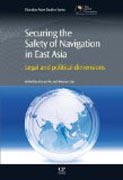
Securing the Safety of Navigation in East Asia: Legal and Political Dimensions
Wu, Shicun
Zou, Keyuan
Safe navigation of the seas is of global importance. Sea lanes provide vital connections for the growth of the global economy and the wellbeing of people everywhere. The sea lanes are of particular importance for the East Asian region, as most trade is undertaken on the ocean. Booming economies in the region such as China and Vietnam put more pressure on sea lanes, triggering concern for the safety of navigation. Securing the Safety of Navigation in East Asia identifi es salient issues for academic debate, and further explores those that have practical implications for the safety of navigation in East Asia. Contemporary maritime security concentrates on safe navigation and inhibiting transnational crimes, including sea piracy and maritime terrorism. Maritime environmental security and search and rescue at sea are also important. Securing the Safety of Navigation in East Asia is structured into four sections: the first part introduces the topic, and looks at the safety of navigation and the search for a cooperative mechanism. The second part considers the international legal framework and its implications for East Asia. The third part presents national perspectives on the safety of navigation, and fi nally part four considers navigational issues in the South China Sea. Places a special focus on East AsiaAccommodates national perspectives in East Asia on navigation given by scholars from China, Japan, South Korea, Malaysia, the Philippines, and SingaporePresents a special section on the South China Sea, located in Southeast Asia and connecting the Indian and Pacific oceans; a critical sea route for maritime transport INDICE: Part 1 Introduction: Safety of navigation in East Asia: Seeking a cooperative mechanism. Part 2 international legal framework: Implications for East Asia: Navigating the currents of legal regimes and realpolitik in East Asia's maritime domain; Compulsory pilotage and the law of the sea: Lessons learned from the Torres Strait; Navigational rights and marine scientific research: A further clarification? Part 3 safety of navigation from national perspectives: South Korea and the safety of navigation: Uncertainty derived from undefined fences; A Japanese researcher's perspective on maritime navigation; Freedom of navigation and peaceful uses of the seas: UNCLOS, Chinese perspectives and personal thoughts; Foreign military activities in the EEZ: Preliminary views from Malaysia; Singapore's South China Sea policy: Implications for the freedom and safety of navigation. Part 4 Navigational issues in the South China Sea: Cooperative mechanism for safety and security of navigation and ocean governance in the South China Sea; Rethinking the coastal states and user states' interests in the South China Sea: bridging the perception gap and sharing the responsibilities; Cross- strait cooperation on search and rescue in the Taiwan Strait and its implication for the South China Sea; The use of PSSAs in the South China Sea; Towards a mandatory port state control system in the South China Sea.
- ISBN: 978-0-85709-489-6
- Editorial: Chandos Publishing
- Encuadernacion: Cartoné
- Páginas: 304
- Fecha Publicación: 31/10/2013
- Nº Volúmenes: 1
- Idioma: Inglés
